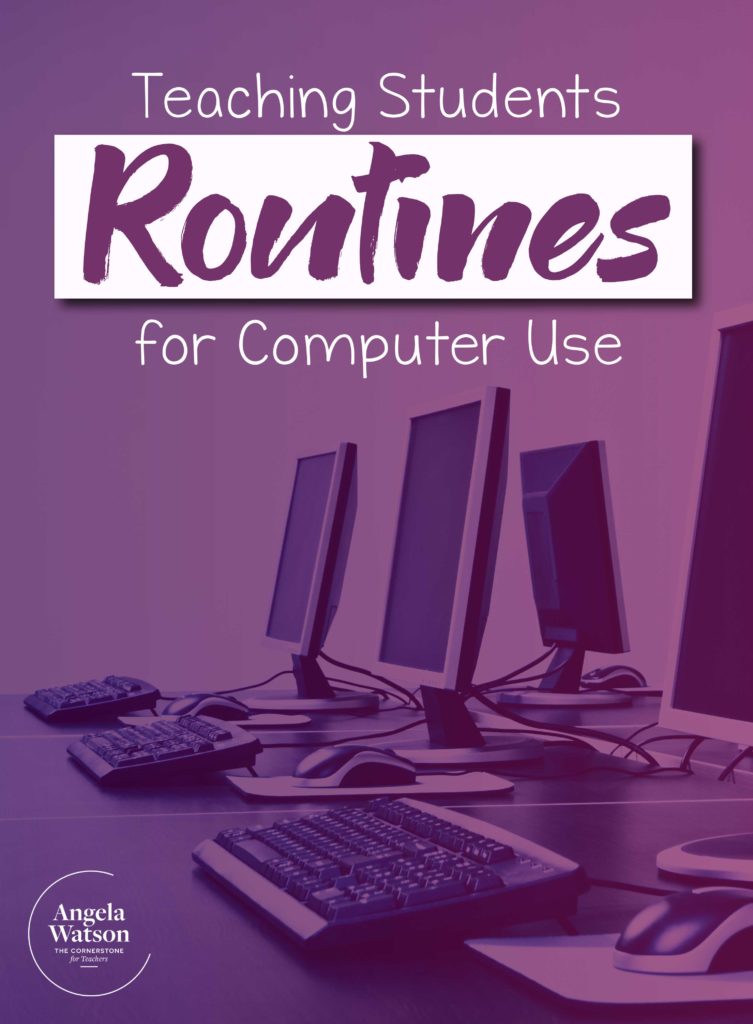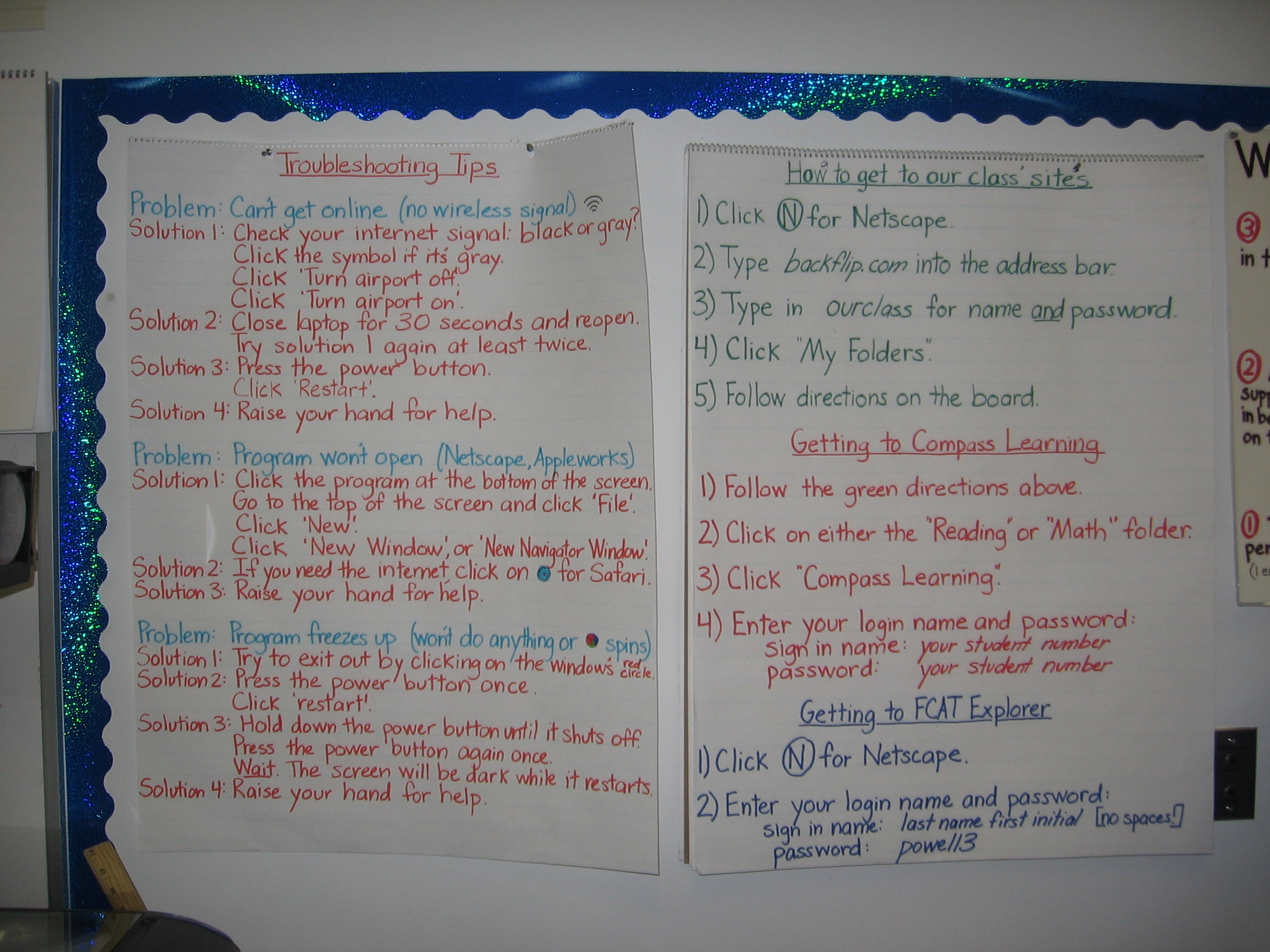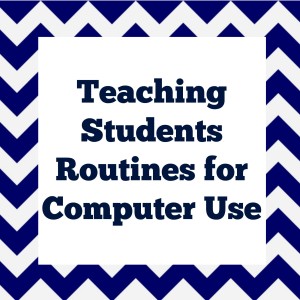This page has technology teaching resources to support educators in creating expectations for computer use, and managing both instruction and behavior. Learn how to teach computer procedures and design effective lessons for the computer and acceptable computer use.

Teaching kids to be independent
There are a special set of skills that students need in order to use computers responsibly and independently. With primary grade students, I recommend spending an extensive amount of time during the first few weeks of school teaching about computers and teaching computer literacy. Show the kids how to handle laptops properly, use basic applications, surf the internet safely, and troubleshoot when things go wrong. These are procedures that need to be taught explicitly, modeled, practiced, and reinforced, like any procedure or routine.
I teach kids to refer to a Troubleshooting Tips chart anytime they have a problem so that the LAST solution is to raise their hands and ask for help: if anyone has their hand up, it’s because they’re already tried to troubleshoot on their own and with a partner.
As a classroom teacher, I also liked having two Computer Specialists or IT Techs (information technology technicians) as a classroom job so that there are two student ‘experts’ that others can ask for assistance if I am busy or kids don’t want to wait for me while I help someone else. By the third month of school, my third graders were almost completely independent on their laptops and rarely asked for help.
To the left in the photo above is my Troubleshooting Tips chart and Login chart that showed my students how to log on to the various sites we frequently access. I found that the kids didn’t have much trouble remembering their passwords, they just couldn’t remember which log-in names and passwords to use for which programs! This chart simplifies things so that all I had to write on the board was “Get  your laptop and go into Compass math” and the kids knew exactly how to get there.
your laptop and go into Compass math” and the kids knew exactly how to get there.
8 tips for strong instructional routines with computers
Here are some ideas to help you create routines with laptops and classroom computers:
- Teach students to use the same computer every time.This gives a greater sense of accountability to students, and helps you figure out what went wrong if there are random files downloaded to the desktop, etc.
- Give instructions BEFORE students get on the computers.Once they have a computer in front of them, kids won’t want to listen to you. Show the websites/activities on your classroom projector and give directions, then have students open their laptops or situate themselves on your classroom computers.
- If you need to give directions while students are at their computers, walk students through the steps at a quick pace.Don’t ask “Is everyone on this web page? Everyone got their password entered?” Just look around: if most screens are at the right place, give the next direction. Don’t make the whole class wait for a handful of kids who aren’t ready: move on, anyway. Students will eagerly help one another out as needed, and once the class is settled, you can circulate to troubleshoot with the ones who have fallen behind. But if you try to troubleshoot before the rest of the class is engaged in their task, the ones who are ready will become restless and disruptive. If you are consistent with this procedure, students who aren’t keeping up will learn to wait patiently, because they know as soon as you’ve got the rest of the class on task, you’ll help them out.
- Focus on maintaining a calm demeanor.Many teachers get stressed out when students are working on computers, because there are so many things happening at once (“My computer froze!” “I can’t get it!” “What do I click?” “Can you help me?”) Take deep breaths and try to project a nonchalant attitude. Kids pick up behavioral cues from the teacher, and if they see that you’re frustrated easily, they may act the same way. Try to approach computer time with the mindset that technology does not always work the way we want it to, and that’s okay–model how to be patient and use problem-solving skills.
- Make sure important websites and passwords are displayed and set up clear procedures for troubleshooting. Then when students ask “Which site are we on?” or “How do I login?”, you can gesture toward the sign and let the kids problem solve. Teach (model, practice, reinforce just like any procedure) what kids should do if they’re stuck. Sometimes I designate two or three tech-savvy students to be “IT Support”, and the rest of the class knows they can ask those students if they need help. With other classes, I teach kids to ask the person next to them for help, or to give a special hand signal (two fingers in the air, etc.) that tells me they need assistance.
- Always have something for students to do when they finish early. Kids shouldn’t have to ask what to do, or worse, find their own form of entertainment. When they complete their task, they should have a list of fun educational games or other things they can do.
- Have an alternate activity planned in case something goes wrong with your lesson. What if the internet is down or too slow? What if a site is blocked? What if your subscription to a site is no longer valid? (Yes, all three of these have happened to me. Repeatedly!) Haveat least two other things students can do, preferably things that are similar to past assignments so it won’t take a lot of explanation. Then you can say, “OK, the site appears to be down. I’m going to troubleshoot, and while I work, I’d like you to go to this website instead. In five minutes, I’ll either tell you to resume the original assignment, or stay on the other site.”
- Give meaningful, engaging assignments, preferably ones that allow students to work at their own pace.Remember, the goal is to minimize time off task. Don’t make the entire class sit passively at ANY time. If you make them wait while three kids struggle to get online, and then again while you reprimand a few kids for being off task, and then again to make sure everyone’s gotten to the right website, the learning environment will be chaotic because the kids are frustrated. Give the assignment in the beginning–preferably before students even get on the computer–and allow the kids to stay focused on their work. They’ll be much more engaged and productive if they don’t have to keep pace with the whole class, so whenever possible, give projects and assignments that are open-ended or student directed. Technology makes differentiation easier than ever.
Printable resources for setting acceptable use policies/managing computer use
Here are some other computer teaching resources to help you in teaching computer literacy and responsibility:
Student-Brainstormed Laptop Guidelines/Expectations: When first introducing computer expectations to students at the beginning of the year, brainstorm some projects kids would like to try and use them as a springboard for instruction. Create rules together through a class discussion: what do you think our class’ expectations should be for using computers in school? What should the consequences be for students who do not meet those expectations? Have students brainstorm what THEY think the rules for computers should be, and write down their answers. This is an example of what a sixth grade class suggested.
Student Contract for Using Computers: After brainstorming the rules, have students sign a contract (acceptable use agreement) agreeing to use the computers according to class guidelines/expectations. Go through the contract line by line with students to explain it and have students initial each portion. This template was designed with a team of sixth grade teachers who wanted students to view assignments that integrate technology as a privilege and a choice that demands certain responsibilities (which are outlined in the computer rules/expectations that the class generated.)
Student Laptop Assignment List: Use this form to list which students are assigned to use which computer. Keep it posted in your classroom to make sure students know which computer is theirs to use.

Angela Watson
Founder and Writer
Discussion
Leave a Reply
OR

Join our
community
of educators
If you are a teacher who is interested in contributing to the Truth for Teachers website, please click here for more information.

















Thank you for sharing your great stuff!
You’re very welcome, Loralee! 🙂
Great ideas for Teaching Kids to be Independent!!!!
I agree!! The earlier we can get students to be independent workers and thinkers the better.
Good moring,
Angela thank you for the wonderful information. I am about to begin my first year as a computer lab Aide in and Intermediate school. This school system doesn’t have PD for the couputer lab aide or techs. Do you have any suggestion of any type of PD that I could attend to help bring in great information for the students and staff at my school? My principal is willing to send me to PD as long as it close to were we live or surrounding states. I live in North Alabama and would love to bring new and innovative technology to our school.
Thanks.
Thank you for this! As a first year Technology teacher, this really helps!
Thank you. I appreciate your affirmation that kids need to be able to work at their own pace as well as letting more experienced kids help others with the technology.